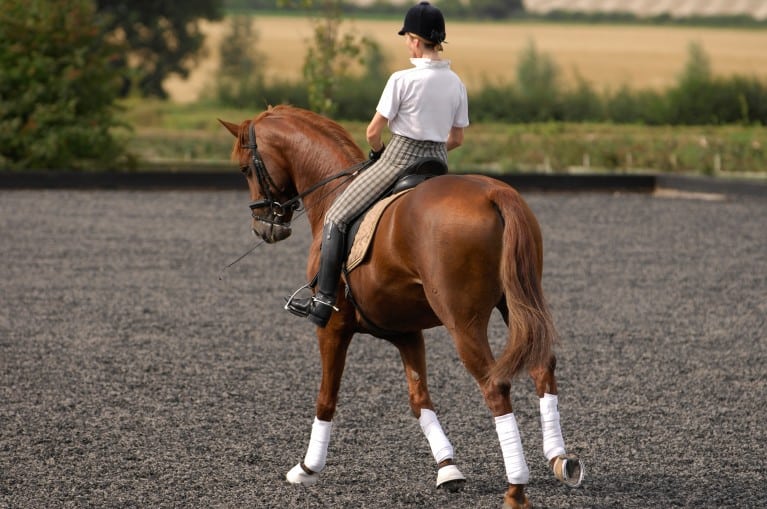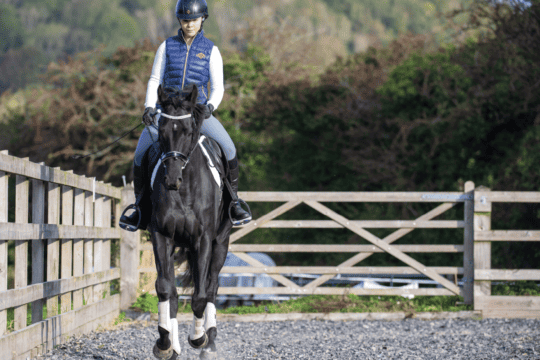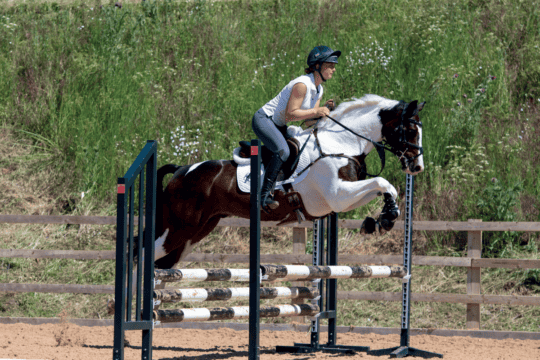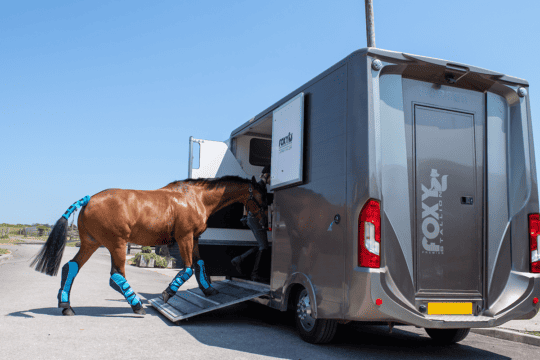-
Riding Schooling and Training
-
Health and Veterinary
-
Management
-
Mind Matters
-
Buying and Selling
-
Insurance Advice
FAQs
Need impulsion, straightness, a good contact and a relaxed horse? Here’s how…

Want a horse who is not only a delight to ride and handle, but is sure-footed and more likely to stay sound? Here’s how to get started on the path to flawless flatwork!
Impulsion
Every ridden thing you do with your horse requires energy, and if you have enough energy, your horse will perform the movements better and more easily.
For example, think of approaching a fence, and how more likely you are to clear it if your horse is taking you forward into the jump, rather than backing off it. And remember that like people, some horses are lazier than others, and may need more rider input to get them going.
Generate more interest by popping your horse over a fence during your schooling session, or some raised poles, if you’re not a keen jumper. Aim to get him moving forward willingly, without the need for nagging.
Training guide – Aim to get your horse moving forward willingly, here’s how…
1. Click and kick
Dressage rider, Carl Hester uses a simple, but effective, exercise to sharpen up lazy horses and add expression to paces. If your horse is being lazy, click loudly with your voice and immediately ask him forward with the leg. After a while, you should find you only need to click and your horse goes.
2. Pole work
Trotting poles are a great way to add interest and increase energy. For even more expression, raise them on to bricks at alternate ends.
3. Ride your corners
As you approach corners, think of riding forward into the corner, asking for more impulsion. If you don’t, your horse will use the corner to slow down and will come out of it lacking even more energy than he went in with. This is really important if you want to pick up extra marks in a dressage test.
Top tip
Finish schooling on a good note and reward your horse by stroking his neck. Walk him for a few minutes to let him cool off.
Straightness
If you’ve ridden young or green horses, you’ll be aware how wiggly they can feel – in fact, it can be difficult to ride some of them straight for more than a couple of strides! But what is true straightness, and how can you teach your horse to move his body in a straight line?
Event rider and trainer, Chris Bartle thinks of the horse being on-line – where he follows a track chosen by the rider, like a rally car going around a bend – and in-line – where the horse is straight through his whole body, even when on a circle or turning.
Think of the horse’s body as a train with six carriages – head, neck, withers, body, hips and tail. As long as the train doesn’t derail, it stays on track.
Achieving straightness
Remember… your horse can’t be straight if you’re not straight. So if you feel your riding is contributing to your horse’s one-sidedness, book some lunge lessons and take up Pilates or yoga. These will all help work both sides of your body evenly, and will improve your seat and posture.
When you first get on your horse, ask someone on the ground to check that you have equal weight and length in both stirrups and reins. Or if your school has mirrors, use these to check.
Next, close your eyes in walk and feel whether your horse’s hind hoof prints are following into his front ones. The likelihood is, he will feel as if his quarters swing slightly to one side. If so, correct the front end to bring it back in line with the quarters. So if he’s slightly quarters right (as most are), you’ll need to bring his forehand (shoulder) slightly to the right.
Training guide – Is your horse on the straight and narrow? Here are ways to help him…
1. Transitions
Ride plenty of transitions between paces, ensuring the horse stays forward to your aids and responds immediately. Carl Hester is a great fan of transitions and says: “You can never do too many! I will literally do hundreds sometimes, if I feel the horse needs to be more attentive.”
2. Outside bend
Placing your horse in a little outside bend is a good straightening exercise, especially when you do it on the rein that your horse bends more easily. So if your horse finds bending left easier, do the exercise on this rein, but in slight right flexion.
3. Leg-yield
Trot a 15m circle, then leg-yield out to about 20m. Watch out for your horse trying to escape through a shoulder or his hindquarters – keep him straight!
4. Counter-canter
Canter across the diagonal of the school, into counter-canter. Don’t worry if your horse breaks to trot or only manages one stride of counter-canter – work on it. You’ll be amazed how quickly he learns.
Contact sport
Most horses will naturally want to take more weight in the left rein than the right one, but this becomes a problem if the rider then starts to pull the horse round more on that rein, only making matters worse.
Often, getting a horse to accept a contact is a waiting game and, providing we do our bit – which is to keep a consistent contact, and use our legs and seat to keep the horse’s hindquarters engaged – then it is only a matter of patience.
When you are teaching your horse to become better in his mouth, make sure you include plenty of turns and circles, as it is easier for him to evade the contact on straight lines.
Event rider, Nick Gauntlett says: “The weight of a contact can vary from horse to horse, but aim for the weight of a small bag of sugar. And remember, you can’t have a tug of war on your own, so if your horse pulls and you pull back, he will keep on pulling. If you stop pulling against him, there is nothing for him to pull against.”
Training guide – Encourage your horse to seek the contact, here’s how…
1. Forward thinking
Be quick to correct your horse if he loses impulsion – an effective nudge with the legs should be enough. If not, back up your leg aids with a flick of the whip.
2. Vary the outline
Supple horses can stay in balance, regardless of where their head and neck are. Change between working your horse in a higher outline, and long and low.
Carl Hester says: “Higher, closer-together hands encourage a higher outline, and lower, wider hands place pressure on the bars of the mouth, therefore encouraging a lower outline.”
3. Leg-yielding
Trot a 15m circle, then leg-yield out to a 20m circle. Make sure you keep your horse working forward into a contact.
Relaxation
Good training is about keeping the horse both mentally and physically relaxed, because it is a lot harder to train one who is nervous or tense.
If your horse feels comfortable, he is more able to listen to you and take on board what you are ‘saying’. The best way to keep your horse relaxed is to give him clear signals.
Horse&Rider’s Editor, Nicky Moffatt, says: “I talk to my horse, Lucy, a lot when I ride her and she has learnt a lot of words. Now, if I say ‘good’, her ears go forward. If I say ‘no’, they go out to the side, as if she’s listening. She also understands ‘whoa’, ‘walk’ and ‘trot’, and will respond to my voice alone, although obviously I don’t use my voice in the dressage arena!
A lot of it is down to the tone of your voice so, for example, I will always say ‘good’ in a soft tone and ‘no’ in a harsher one.
“Horses are so receptive. I remember reading once that Carl Hester used to carry his mobile phone with him when he was riding his horses, until they started screeching to a halt every time it rang!”
Training guide – Here are some ways to keep your horse relaxed and you, too!
1. Rhythm and balance
When you’re stretching your horse, make sure that he stays in the same rhythm. If he tries to rush or falls on to the forehand, take the rein contact up again, put him on a circle and try again.
2. Break time
Give your horse a break when you feel he needs one, but only when he has done something well. Either gradually allow the rein contact forward, so that he can stretch down. Or if he needs to get his breath back, quietly ask him to walk and then gradually allow the rein out, rather than throwing away the contact altogether.
Dressage trainer, Andrew Day says:
“I don’t think horses get bored of going in the school, I think they get bored of being nagged and pulled around in the school. As long as you are fair, your horse should stay happy.”
Are you ready to start fine-tuning your horse’s flatwork? Our article, Flawless flatwork: moving on up has some great tips for you
Your Comments
2 thoughts on “Flawless flatwork: Getting started”
Leave a Reply
You must be logged in to post a comment.









Do you have any charts (Floor Plans) showing a series of schooling movements on the ground, such as Circles and Turns and Lateral Movement. Or can you tell me where I can find such charts?
Jimmy Hartley
Hi Jimmy,
We have lots of great schooling diagrams here are just a few, https://www.horseandrideruk.com/expert-advice/articles/five-exercises-to-try-this-week/